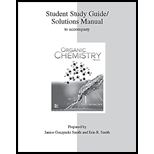
Concept explainers
Propose a structure for a compound of molecular formula
Want to see the full answer?
Check out a sample textbook solution
Chapter 14 Solutions
ORGANIC CHEMISTRY-STUDY GUIDE PACKAGE
Additional Science Textbook Solutions
Chemistry: The Central Science (13th Edition)
Chemistry: The Central Science (14th Edition)
CHEMISTRY-TEXT
Chemistry: Atoms First
Organic Chemistry
Chemistry & Chemical Reactivity
- What is the structure of the compound with the formula C5H12O, if it has a strong broad IR signal centered near 3330 cm-2, and the 1H-NMR spectrum is: 0.91 ppm (3H triplet) 1.19 ppm (6H singlet) 1.50 ppm (2H quartet) 2.24 ppm (1H singlet)arrow_forward1. There are several isomeric alkanes of molecular formula C6H14.Two of these exhibit the following 1H-NMR spectra. Propose a structure for each of the isomers. Isomer A: δ = 0.84 (d, 12 H), 1.39 (septet, 2H) ppm Isomer B: δ = 0.84 (t, 3 H), 0.86 (s, 9H), 1.22 (q, 2H) ppmarrow_forwardThere are several isomeric alcohols and ethers of molecular formula C5H12O. Two of these exhibit the following 1H-NMR spectra. Propose a structure for each of the isomers. Isomer A: δ = 0.92 (t, 7.8 Hz, 3 H), 1.20 (s, 6H), 1.49 (q, 7.8 Hz, 2H), 1.85 (s, 1H) ppm Isomer B: δ = 1.19 (s, 9 H), 3.21 (s, 3H) ppmarrow_forward
- An organic compound B with formula C6H14O has the following: IR Spectroscopy 2974 cm-1, 1080 cm-1 Mass Spectrometry 102 (M+), 87, 73 1H NMR Spectroscopy Eight signals at δ 1.10 (d, 3H), 1.13 (dd, 3H), 1.14 (dd, 3H), 1.59 (ddq, 1H), 1.60 (ddq, 1H), 3.19 (ddq, 1H), 3.51 (dq, 1H), 3.50 (dq, 1H). Compound B is obtained by the reaction of compound A with NaH followed by CH3CH2Br. The stereochemistry of A is "S" Using this information, deduce a plausible structure for Compound A with correct stereochemistry.arrow_forwardIdentify this compound with molecular formula C9H10O IR peak at 1742 cm-^1,H nmr data (ppm) at 2.15(singlet,3H),3.70(singlet.2H) and 7.20(broad singlet,5H)arrow_forwardThere are several isomeric alkanes of molecular formula C6H14. Two of these exhibit the following 1H-NMR spectra. Propose a structure for each of the isomers. Isomer A: δ = 0.84 (d, 12 H), 1.39 (septet, 2H) ppm Isomer B: δ = 0.84 (t, 3 H), 0.86 (t, 9H), 1.22 (q, 2H) ppmarrow_forward
- Deduce a possible structure for the compound with the IR absorptions below. C5H8O: 2950, 1750 cm-1 C4H8O: 2950, 2820, 2715, 1715 cm-1arrow_forwardThe 1H-NMR spectrum of compound R, C6H14O, consists of two signals: d 1.1 (doublet) and d 3.6 (septet) in the ratio 6:1. Propose a structural formula for compound R consistent with this informationarrow_forwardPropose a structure consistent with each set of data.a.) C9H10O2: IR absorption at 1718 cm−1 b.) C9H12: IR absorption at 2850–3150 cm−1arrow_forward
- Treatment of 2-methylpropanenitrile [(CH3)2CHCN] with CH3CH2CH2MgBr, followed by aqueous acid, affords compound V, which has molecular formula C7H14O. V has a strong absorption in its IR spectrum at 1713 cm−1, and gives the following 1H NMR data: 0.91 (triplet, 3 H), 1.09 (doublet, 6 H), 1.6 (multiplet, 2 H), 2.43 (triplet, 2 H), and 2.60 (septet, 1 H) ppm. What is the structure of V? We will learn about this reaction in Chapter 20.arrow_forwardPropose a structure for the compounds that display IR spectra with the following peaks : A) C2H3O2CL: 3200-2500 BROAD ,1720,1410cm-1 B) C8H8O: 3030, 2820, 2760, 1715, 1605, 1495, 1410, 750, 695cm-1arrow_forwardAddition of m-xylene to the strongly acidic solvent HF/SbF5 at 45C gives a new species, which shows 1H-NMR resonances at 2.88 (3H), 3.00 (3H), 4.67 (2H), 7.93 (1H), 7.83 (1H), and 8.68 (1H). Assign a structure to the species giving this spectrum.arrow_forward
 Organic ChemistryChemistryISBN:9781305580350Author:William H. Brown, Brent L. Iverson, Eric Anslyn, Christopher S. FootePublisher:Cengage Learning
Organic ChemistryChemistryISBN:9781305580350Author:William H. Brown, Brent L. Iverson, Eric Anslyn, Christopher S. FootePublisher:Cengage Learning

